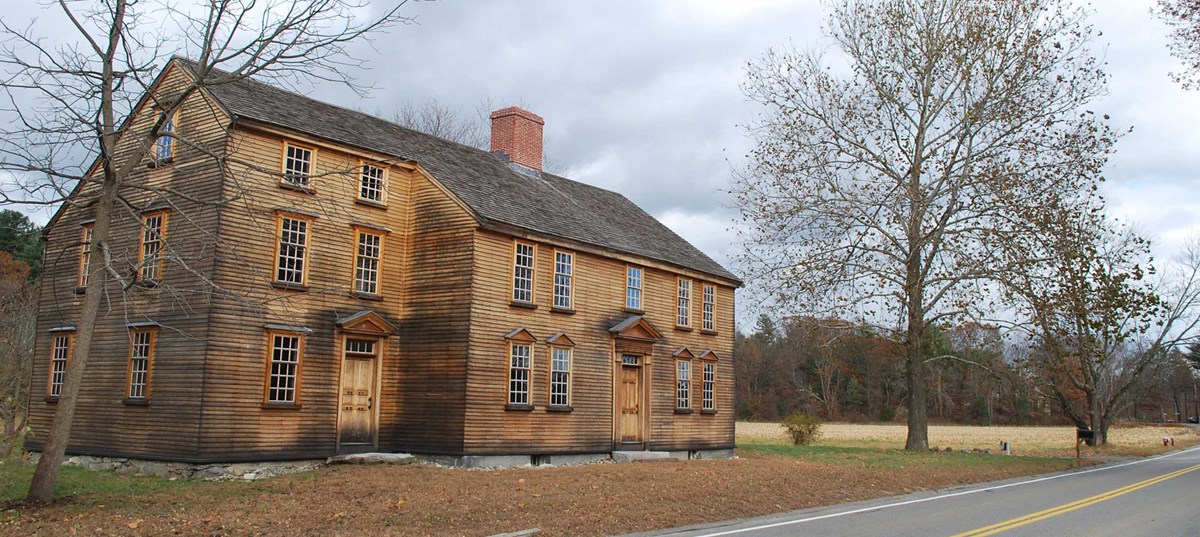While the 52nd Regiment was in Boston, Capt. Browne commanded its light infantry company. That means he led those men out to Concord on 18–19 Apr 1775.
Browne had been to Concord before. On 20 March, he and Ens. Henry DeBerniere visited the town in civilian guise to confirm a local informant’s reports to Gen. Thomas Gage that militia colonel James Barrett was amassing arms there, including four cannon spirited out of Boston armories.
The two army officers did confirm that the Patriots had those four brass cannon “concealed in some place behind the town, in a wood.” That wording suggests they didn’t see the hiding-place but were told where it was. One source of information was probably the local lawyer Daniel Bliss, who felt so unsafe having suspicious visitors in his house that he went into Boston with Brown and DeBerniere. (Gage’s original informant remained in town.)
Browne, DeBerniere, and Bliss returned as part of the army expedition to Concord on 18–19 April. In fact, we know from other officers’ reports that Capt. Browne and his light infantrymen were among the three companies who went all the way to Barrett’s farm, a mile past the North Bridge (shown above).
Those redcoats didn’t find significant amounts of ordnance at that farm. On their way back, they did find some of their fellow soldiers killed at the bridge. That was the start of the column’s difficult fight back to Boston.
The 52nd Regiment was also in the Battle of Bunker Hill two months later. According to one source, the regiment ended that day camped closest to the provincial lines on the isthmus of the Charlestown peninsula. Capt. Browne was listed among the wounded.
On 1 August, the British command in London made Capt. Browne a brigade major, an administrative post with a corresponding rise in pay. Gen. William Howe announced that promotion in his orders from Halifax the following May. In 1778, the 52nd Regiment was drafted, meaning its men were distributed to other regiments and it began to recruit new soldiers.
Around that time, Browne was promoted to be the major of the 49th Regiment. Later in 1778 that unit took part in the British conquest of St. Lucia from the French. In 1780 the 49th moved to Ireland. Around the start of 1783 Browne became a lieutenant-colonel in the army. Henry Lawes Luttrell, then serving in the Irish Parliament, told that legislature that:
Colonel Brown was one of the best officers in the army, that he had distinguished himself on service, and was remarkable for a strict observance of discipline in the regiment, and an excellent corps of officers emulated his example—If only that praise had come from a more respectable man.
That’s as far as I can trace William Browne. Again, his common name makes him easy to lose in a crowd.

The WO.25 "Succession Books" at the British National Archives record the commission history of the Capt. Wm. Brown of the 52nd Foot, in 1775, as follows. An Englishman b. in 1749, he was first commissioned as a lieutenant on 2 Nov 1761 by raising men for rank in the new 107th Foot, from where he transferred to a lieutenancy of 17 Nov 1762 in the 5th Foot. Put on the Half-Pay List on 25 Apr 1763 at the war-end reductions, he exchanged back onto active service in a lieutenancy of 6 June 1766 in the 14th Foot, and went from there to a captaincy of 24 June 1771 in the 52nd Foot, got by purchase. He left the 52nd by purchasing the majority of the 49th Foot on 12 Oct 1778, the rank in which he retired on 26 Oct 1786, having in the meantime been breveted lieutenant-colonel on 31 Dec 1782. His surname is spelled without an "e" in the War Office's registers. (JAH)
ReplyDeleteThank you for sharing that information! It appears that like Browne, like De Berniere, was a teen-aged army officer, and still only in his mid-twenties during his trips into the Massachusetts countryside.
ReplyDelete(Comments don’t appear automatically and immediately on this blog because too many of them are spam.)